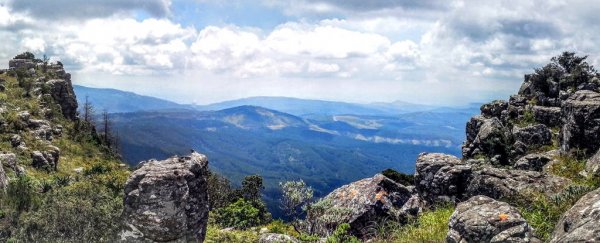South Africa's Makhonjwa Mountains are home to some of the oldest rocks on the planet – but not everything in this magnificent landscape originated on Earth. Scientists say they've discovered trace evidence of extraterrestrial organic matter buried within volcanic sediment from over 3.3 billion years ago.
"This is the very first time that we have found actual evidence for extraterrestrial carbon in terrestrial rocks," astrobiologist Frances Westall from the CNRS Centre for Molecular Biophysics in France explained to New Scientist.
For billions of years, Earth has been rained upon by meteorites violently impacting and rearranging the planet's surface. What do these space rocks leave behind when they get here?
It could be a lot.
Many scientists think some of the building blocks for life on our planet may have arrived as space-faring molecules; the new discovery in South Africa adds further weight to this tantalising possibility.
In a volcanic deposit called the Josefsdal Chert – which is part of the Makhonjwa Mountains region (aka the Barberton Greenstone Belt) – Westall and her team uncovered a 2 mm-thick rock layer characterised by two "anomalous" signals.
Using electron paramagnetic resonance (EPR) spectroscopy, the researchers found that the 3.3 billion-year-old rock contained two types of insoluble organic matter, both of which suggest extraterrestrial origins (the oldest extraterrestrial organic matter ever identified no less).
One of the EPR signals resembles something scientists have seen before in carbonaceous chondrites: ancient meteorite samples containing organic compounds.
The other anomalous reading – suggestive of nanoparticles of nickel, chromium, and iron – is not something usually seen in terrestrial rock formations, and also strengthens the argument that parts of this thin rock layer originally came from somewhere much, much farther away.
"Ni-rich chrome spinels, also referred to as 'cosmic spinels', are formed during the entry of extraterrestrial objects in Earth's atmosphere," first author of the new research, chemical engineer Didier Gourier from PSL Research University, explained last year.
As for how these two different and contradictory EPR signals could exist within the Josefsdal Chert at the same moment in history, the research team say it's hard to know for sure.
"It is difficult to envisage a single impact event preserving both organic matter and spinel particles in such a thin sedimentary layer," the authors write in their paper.
"On the one hand, hydrogenated organic matter can survive only if the temperature of the falling matter does not exceed a few hundred degrees. On the other hand, cosmic spinels are formed by a high degree of melting of the object, as it falls towards the Earth's surface."
In their hypothesis, the researchers propose that fallout from a hail of micrometeorites might have mixed in the atmosphere with volcanic ash clouds, and as the matter slowly drifted down to Earth's surface, traces of extraterrestrial carbon were preserved alongside newly formed cosmic spinels, and were preserved together for billions of years.
"The organic matter from the carbon-rich meteorites must have been raining down at quite a high rate," Westall told New Scientist.
Of course, this all remains very much hypothetical for now. And even if this scenario was how it happened, we don't know what form this ancient organic matter once took – nor can we be sure if its raining down upon Earth was somehow linked to the evolution of life as we know it today.
Still, it's a major discovery in the science of extraterrestrial organics, and all the unknowns make for excellent avenues to keep exploring.
The findings are reported in Geochimica et Cosmochimica Acta.
